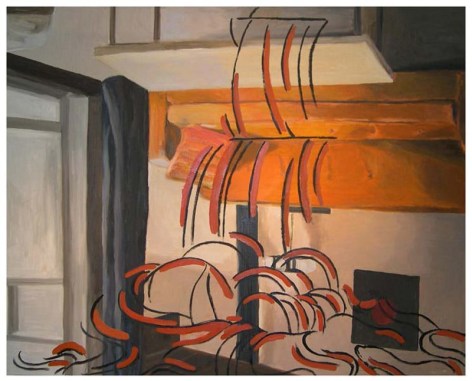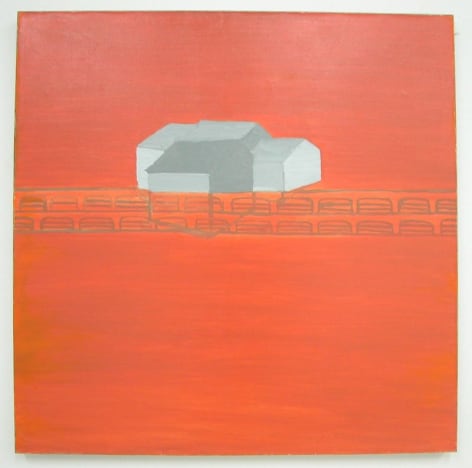The Inverse Mirror was curated by Paul Laster and features paintings by Cai Jin, David Diao, Zhao Gang, Richard Tsao and Zhang Hongtu.
An exhibition of five contemporary Chinese painters who challenge our perceptions of history while reflecting their own inner natures, The Inverse Mirror transports the viewer to an imaginary place, a place projected into reality with paint, brushes and canvas for our contemplative gaze.
Red dominates the expressive canvases of Cai Jin. Her intense portrayal of the decomposing Beauty Banana plant, indigenous to her native Anhui in Southeastern China, is like a blood-torn memory that beats in her soul. She obsessively returns to the decomposing leaves and stalks, losing herself in an energetic yet meditative painting process. Cai Jin’s absorbing works are somewhat surreal and undeniably visceral.
David Diao began his artistic vocation in the ’60s as a minimalist, a trait still evident in his subtle works. Intermixing a deep interest in modernism with issues of identity, he creates paintings that question his own reality while picturing himself in an alternative time and space. Appropriation, representation and color field painting meet head-to-head on his canvas, amalgamating into a sublime and sophisticated work of art.
Coming of age during the Cultural Revolution, Zhao Gang rebelled against authority to become the youngest member of the radical Xing Xing (Star Star) group in 1979. His stylized landscapes, zodiac symbols and architectural structures are cultural memories recalled by impulsive marks on sparsely colored grounds. In his newest works, Zhao Gang layers folkloric imagery over photo-realist scenes of modern interiors to produce a controlled clash of cultures in a painterly realm.
Richard Tsao cultivates paintings over a lengthy period of time. Like the orchid growers of his native Thailand, he develops and nurtures his process-oriented abstractions until they come into full bloom. Applying layer upon layer of colorful washes mixed with marble dust, he creates a crusty, lichen-like surface of lush luminous hues. Beautiful to behold, Tsao’s transcendental canvases slowly reveal their nuances and reflect the inner light of the creator and meditative viewer.
A conceptual artist at heart, Zhang Hongtu returned to representational painting in 1998 with a highly focused project that mixes Shan Shui (mountain-water) masterworks with the celebrated styles of Cezanne, Monet and Van Gogh. His intelligent combinations and exquisite brushwork extends the tradition of copying old masters and exploits postmodern practices. With a wink of the eye, he adds witty inscriptions and imaginary seals to the surface, finishing the cross-cultural painting with verve.
These five uniquely talented mid-career artists have exhibited extensively and are represented in numerous private and public collections. This show is being held in conjunction with New York's Asian Contemporary Art Week
这次展览展出了五位当代中国画家的作品,这些作品除了对我们的视觉观察具有挑战性外,同时也反映了画家自我内在的本质。倒转的镜子把观众带入了一个以涂料,画笔和画布相结合而创造成的真实地带,令人深思。
蔡锦的画布以红色为主,强烈的色彩描绘了被分解过的美人蕉。美人蕉是蔡锦出生地安徽的土产,是能打动灵魂的鲜血般的记忆。她对分支后叶子和根茎迷恋,自身完全融入其中,深沉在绘画的过程中。蔡锦引人入胜的作品是她敏感而神秘的内心世界的折射。
David Diao 作为极简抽象派艺术家,六十年代开始他的艺术生涯。他的绘画作品以精巧为明显特点,混合着现代想法和对关于身份的议题的兴趣。他画作的一系列作品对自身本 体提出疑问,并将自己的照片穿插交替在不同时间和环境中。具有代表性的颜料综合在他的画布上,画作出壮丽,成熟的艺术作品。
来自文革年代的赵刚,作为在1979年反对执政者星星群的年轻一员,他画作的风景和具有象徵意义的建筑构造在稀疏的颜料下衬托出的强烈符号。这都是他对人民文明的反应。在他最新的作品中,赵刚结合民间艺术图案和现代室内摄影,创作出具有文化碰撞的作品。
曹国祖的作品是经过长久创作而成。 就好像泰国兰花的种植者,从生长到全部盛开的过程精心培育。 一层层的颜料与大理石粉混合,洗刷而成。他画作油亮的外壳表面,多彩而亮丽。曹国祖精致的画布上映射出了作者内心的光芒,和对观赏者多样的反应。
张宏图作为一名以概念为中心的艺术家,1998年回车代表性油画,结合着名的西方画家塞尚,莫内,凡高的画风和中国山水画为主题。这种具有才智的结合与精美 的笔锋,延伸了传统的临摹画和对现代艺术的功力。他更在表面加入了风趣的文字和印章,完成了具有气魄与表现文化交叉的油画。
这五位独特的艺术家的作品被许多私人和公共收藏。






